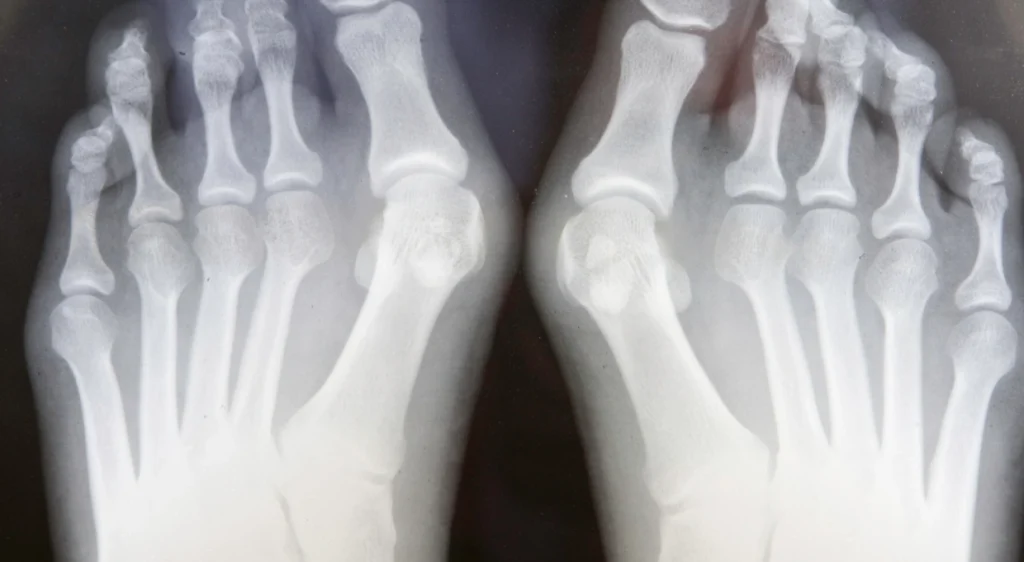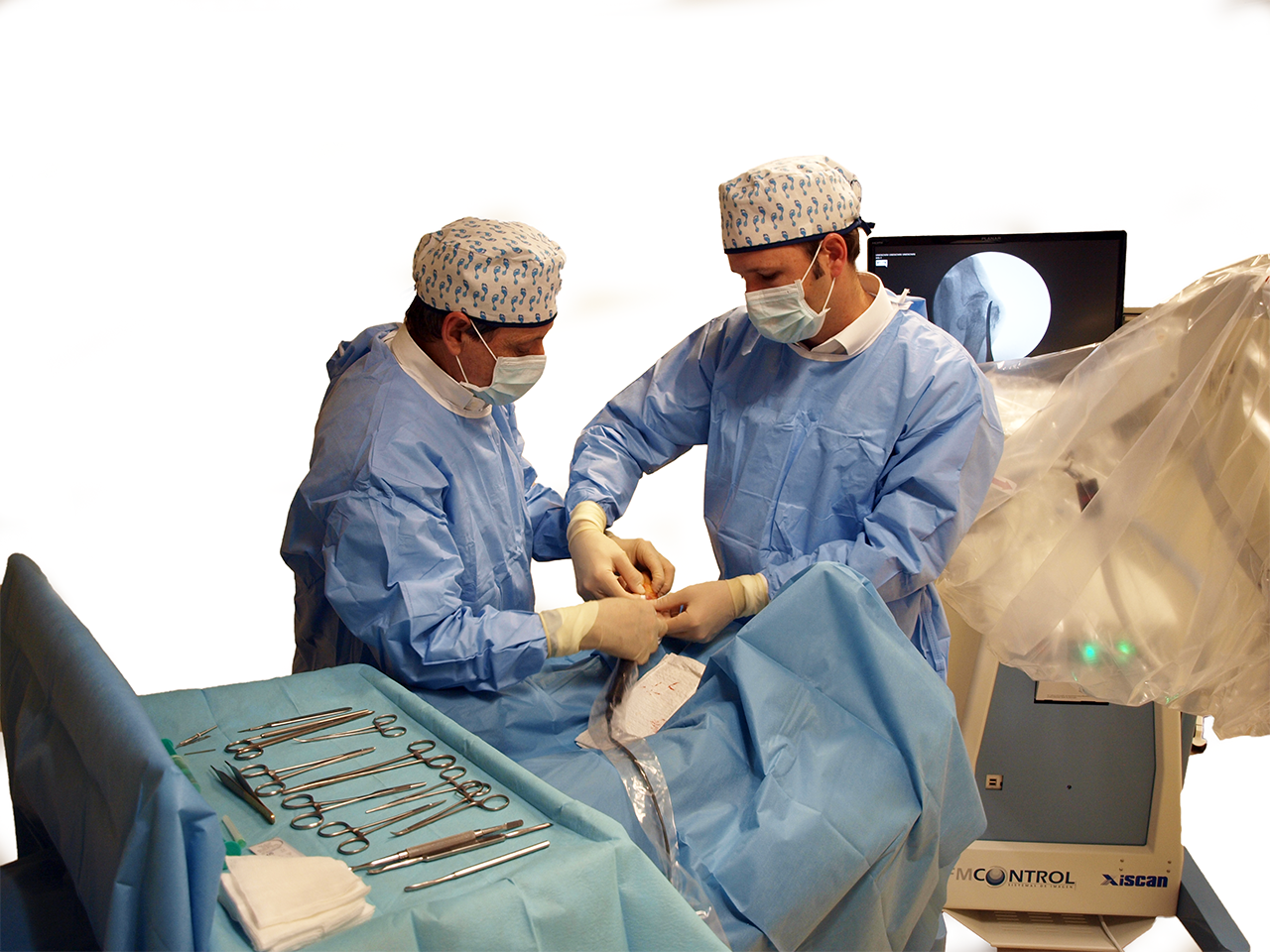What types of bunion surgery are there?
Hallux valgus is the most common deformity of the forefoot and is characterized by a lateral deviation of the base of the first toe and the first metatarsal, resulting in the appearance of a lateral protrusion commonly called a bunionette.
Being a progressive disease, its definitive resolution is always surgical. There are many different techniques, but since the 1980s, percutaneous foot surgery, also known as minimally invasive surgery, has been developed. bunion surgery has reduced the rate of complications, improved patient satisfaction because in addition to having excellent results, it provides rapid recovery and good patient tolerance.
Operation of bunions or hallux valgus
The main objectives of hallux valgus surgery hallux valgus are to correct the deformity of the first toe, to avoid the appearance of metatarsalgia or the appearance of associated deformities in toes such as hammertoes or claw toes. It also prevents hyperkeratosis due to rubbing or pressure from footwear. Finally, major damage such as subluxation of the foot joints is avoided.
The ultimate purpose of all this is to reestablish correct gait biomechanics, achieving the use of the footwear and eliminating pain.
The surgical technique depends on several factors:
- Selection and experience of the medical surgeon or podiatric specialist.
- Type of deformity of the first finger and other associated deformities.
- Patient needs or expectations.
- Patient’s age and associated diseases.
Bunion operations are contraindicated in case of :
- Severe peripheral vascular insufficiency
- Active foot infection
Whichever technique is chosen, it is common to use combinations of osteotomies and soft tissue surgery to solve the problems of angles and deformities.
Types of operations to treat bunions
We have conventional or open bunion surgery, from which numerous variants have been derived according to the defect, type of angulation and combination of other deformities.
Open surgery has been performed for a century. This surgery has the problem of causing more tissue damage, has more complications of consolidation of bone parts, implant rejection and scarring, as well as greater postoperative pain and a longer and more painful recovery.
In the last 30 years, minimally invasive surgery or percutaneous foot surgery has been performed more frequently and with better results, and its advantages are well known:
- Less postoperative pain
- Early start of rehabilitation
- Immediate ambulation
- Return to activities of daily living in less time
- Reduced risk of bleeding
- Minimal tissue damage.
- Barely perceptible scar.
Prior to surgery, a detailed clinical history is taken with a physical examination aimed at defining the magnitude of the biomechanical problem. Previous radiographs are taken to determine the value of the pathological angulations and classify them according to their severity, as well as to appreciate other adjacent defects.
Percutaneous foot surgery is indicated when hallux valgus is mild or moderate. In general, when the hallux angle is less than 25º. In severe cases where open surgery is not possible due to the patient’s age or pathological history, percutaneous surgery may be indicated. In addition, techniques are being developed to resolve more severe cases with this type of surgery.
Minimally invasive surgery for hallux valgus also has different variants, which can be described in general:
- Bunion surgery without osteotomy.
- Bunion surgery with osteotomy.
In any of the cases the approximate duration is 45 minutes. Small incisions of less than 3 mm are made, through which the surgical material specially designed for this purpose is introduced. During the surgery the correct bone alignment is checked by low intensity radiology (fluoroscopy).
Recovery after bunion surgery
After percutaneous surgery, the patient can walk alone wearing special postoperative footwear provided by Clínica San Román. The bandage applied is functional and reduces the pressure exerted during the forefoot treading. The bandage must remain in place for a week until the surgeon removes it and checks its evolution.
Recovery times are shorter with this type of surgery, obtaining safe and effective results.
What is hallux valgus and what are bunions?
The hallux valgus is the medical name for bunions. It is a lateral or outward deviation of the joint of the first toe and the corresponding metatarsal (from the Latin hallux, meaning “big toe” and valgus “outward”) causing a lateral protrusion and deformity of the toes.
The characteristic of bunions is their progression, since they do not improve spontaneously or with physical measures.

What are the main causes of bunions?
Extrinsic factors:
- Obesity or overweight
- Footwear: it has been shown that the use of narrow-toed shoes and/or high heels favors the appearance of hallux valgus.
Intrinsic factors:
- Genetic factors: Heredity is known to play an important role, especially in cases of juvenile onset of bunions.
- Female sex: 90% of the cases are women.
- Age: it is more frequent between 40 and 60 years of age.
- Other injuries or variants in the foot:
- Metatarsus primus varus
- Flat feet
- Achilles Tendon Retraction.
What is percutaneous bunion surgery?
It is a technique developed in the last 30 years, with the purpose of reducing soft tissue damage, reducing complications, with a short and comfortable postoperative period.
Percutaneous bunionette surgery step by step
- Medical evaluation by a foot specialist: detailed clinical history with physical and radiological examination that allows to accurately define the deformities and their angulations in order to choose the best surgical technique.
- Anesthesia: the local anesthetic minimizes the risks compared to the manifestations of a general anesthesia. It allows the patient to walk out of the operating room.
- Incisions: at least 3 incisions are made, the largest of which is 3 mm long, sufficient to introduce the specific surgical instruments to perform the osteotomies and correct the defects.
- Radiology: it is essential during surgery to verify the angles and alignment of the bones.
- Postoperative bandage: at the end of the operation, the bandage should generally be maintained for one week. At the first postoperative consultation, the sutures are removed, a new dressing is applied and fluoroscopic control is performed.
Percutaneous bunion surgery
La cirugía completa tiene una duración media de 60 minutos, dependiendo del estado de salud de cada paciente y del grado de deformidad del hallux valgus.
Dada la complejidad del problema médico que representa el hallux valgus, esta cirugía debe cumplir los siguientes propósitos:
- Repositioning of the metatarsophalangeal joint
- Reducing the intermetatarsal angle (AIM)
- Accommodate the sesamoids in their normal location under the metatarsal head.
- Restore the weight-bearing capacity of the first phalanx
- Align the hallux to its correct position.
What are the advantages of percutaneous bunion surgery?
Percutaneous bunion surgery has many advantages over open or conventional surgery, we can mention:
- Minimal postoperative pain for a few days.
- It does not require immobilization with plaster casts. The functional bandage allows a certain degree of mobilization from the first day. Generally does not require subsequent rehabilitation.
- Immediate ambulation, which reduces the risk of thrombosis. It also has a positive effect on the patient, who does not need bed rest.
- Quick incorporation to the usual activity.
- Lower risk of bleeding and infection.
- Less damage to soft tissues, tendons and ligaments, thus preserving mobility and stability of the foot
- Minimal scarring with positive aesthetic effect.
How long does bunion surgery last?
The duration of percutaneous foot surgery for hallux valgus ranges from 30 to 90 minutes. It is always necessary to take into account the severity of the deformity or the presence of other associated injuries that may prolong the surgical time. However, it is rarely longer than 90 minutes.
The important thing about this procedure is that the patient is awake and conscious during the surgery and that it allows the patient to ambulate with his postoperative footwear without inconveniences.
The application of regional or local anesthesia is a quick process that does not entail inconveniences and allows maintaining the anesthetized area during the surgery.
Time prior to surgery
The patient should come to Clínica San Román about an hour before the operation in order to review the tests and make the surgical preparation. The atmosphere at the Clinic is cordial, warm and professional.
San Roman Dotores, experts in minimally invasive surgery for bunions and claw toes, are pioneers in Europe. They have been performing these procedures since 1979 with excellent results.
Home care after percutaneous surgery
- Elevate the feet to help decrease swelling.
- Apply local cold, avoiding wetting the postoperative dressing.
- Exclusive use of Clínica San Román’s special postoperative footwear for hallux valgus.
- Analgesics: in the first days you can take analgesics and anti-inflammatory drugs indicated by the foot specialist.
- Never remove or wet the bandage.
What is the best bunion surgery?
The best bunion surgery depends on the severity of the deformity and the specific needs of the patient. Minimally invasive surgery, known to cause less pain and allow for faster recovery, is often preferred for less severe cases. Techniques such as osteotomy and arthrodesis are reserved for more complicated cases where more significant correction is required.
When is it best to have bunion surgery?
The decision to have bunion surgery should be based on several factors, including pain and limitation of foot function that impede daily activities, and not solely on the appearance of the bunion. Generally, surgery is recommended when pain is not relieved by changes in footwear or non-surgical treatments, and when the patient’s quality of life is significantly affected.
What is bunion osteotomy?
Bunion osteotomy is a type of surgery that involves cutting and realigning the bone to correct the bunion deformity. This procedure is used to restore normal alignment of the big toe and relieve pain and improve foot function. There are several types of osteotomies that can be performed depending on the location and severity of the bunion.
What is the name of the operation to remove bunions?
The operation to remove bunions is commonly known as bunionette or hallux valgus correction surgery. Within this type of surgery, there are several specific procedures such as osteotomy, exostectomy (removal of bony growth) and arthrodesis (joint fusion), each suitable for different levels of severity and anatomical characteristics of the patient’s foot.
References:
Minimally Invasive Foot & Ankle Surgery: A Review and a Novel Technique.
- Minimally invasive-percutaneous surgery – recent developments of the foot surgery techniques
- Outcomes and Surgical Strategies of Minimally Invasive Chevron/Akin Procedures
Third-Generation Minimally Invasive Chevron and Akin Osteotomies (MICA) in Hallux Valgus Surgery
- Minimally Invasive Foot and Ankle Surgery: A Primer for Orthopaedic Surgeons
- Minimally invasive surgery: has it come of age?
